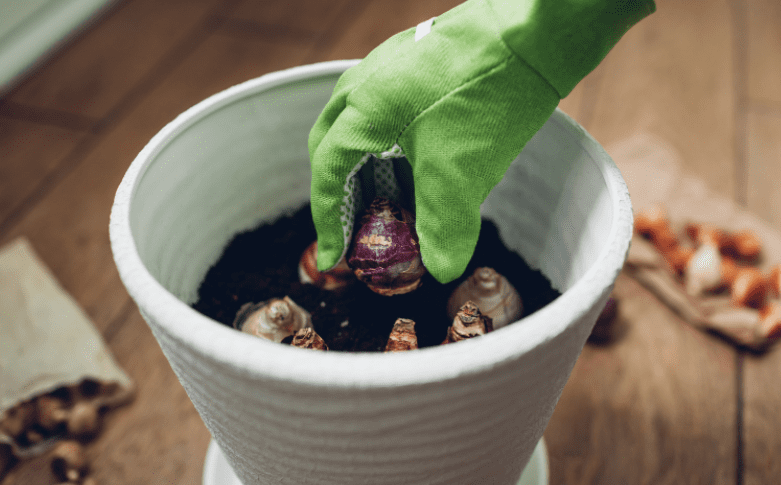Preparing Bulbs For Summer Planting
Planting bulbs for summer in pots is an excellent project to share with children. All are simple to maintain from year to year by transferring the pots indoors for winter.
Bulbs are one of the simplest means of contributing to color into the garden between late spring and autumn, and they are some of the liveliest and most delicate plants available for us to grow.
Alstroemeria, agapanthus, begonias, ranunculus, dahlias, echinaceas, gladioli, and lilies — so many beautiful plants in every color conceivable.
We already have lots of alliums, crocosmia, and gladioli in our borders and several begonias, dahlias, and a canna lily potted up in the greenhouse on windowsills already shooting with this year’s growth.
Some of these are new tubers, others salvaged from last year, and I only had one fatality. I’d kept a dahlia in its container through winter, but when I re-pot it into fresh compost, I found that the whole tuber had vanished, and the compost was home to several vine weevil grubs.
Treating Bulbs For Pests
These insidious pests damage plants at all stages of their life and are a common menace in containers. The adults chew notches in leaves, and the grubs eat roots, which is what does for your plants.
They can be treated with a nematode (microscopic parasite) in summer and a chemical when the weather is cooler.
Alternatively, stand containers in trays of water with no overhanging plants — the adults can’t swim or fly, so they can’t reach your plants!
So this year, I’ve branched out and bought some alstroemerias, gorgeously scented freesias, and unusual echinacea called ‘Green Twister’ that has pale pink petals which merge into the green.
I have planted some of the richly scented freesias in a bowl that I am keeping in the greenhouse until late April or early May, when they will be moved to a seating area for when they flower.
After planting, I went around the garden and fed returning bulb shoots with a multipurpose granular fertilizer, forking it in and watering afterward.
Some Bulbs Demand Individual Care
Although most summer bulbs can be planted out now, some don’t like the slow, cold start to our summers, and these should be potted up in fresh compost instead.
Dahlia, begonia, and canna tubers are the main ones that need a warmer start, so after you have potted them, upkeep them in a frost-free greenhouse, on a porch, or with bright light indoors.
Keep their compost Begor damp, not too wet, and they starting “sill should soon begin to shoot.
Once they are large enough, you can gradually acclimatize them to outside temperatures before planting them out in borders or tubs.
Tubers and bulbs dislike wet, heavy clay as it holds water, which increases the likelihood of rotting (see panel, right, on how to avoid this).
Echinaceas are another summer favorite that needs a little forethought before committing them to the soil.
These ‘prairie garden’ stalwarts are one of my favorites as they are eye-catching plants, bloom late when other plants are starting to flag and attract a wide range of pollinating insects to the garden.
However, they aren’t always happy in our cold, wet winter soil, so it’s always a relief to see new shoots appearing from our plants in early spring.
If you want to grow them but worry about the wetness of your soil, an option is to make a low mound of soil, grit, and compost and plant the echinacea bulbs on it, so they are raised slightly off the surrounding ground.
How To Plant Freesias Step By Step
- Start filling your container with compost and throw in some blood, bone, and fish.
- Push the freesia bulbs 3in (9cm) deep and about 1in (2cm) apart, make sure bulb noses are facing upwards.
-
Top with extra compost, allowing room for watering at the top, and firm it down.
-
Label and water and place in a frost-clear spot until the weather becomes reliably warmer
Planting Echinacea In Open-Draining Soil
- Firm echinacea bulbs have sets of hairy roots growing from underneath a curled, pinkish tip.
-
They like a free-draining ground, so they dig in portions of good-rotted organic matter and include fertilizer such as blood, bone, fish, or Growmore.

3. Delicately extended the roots and nestle the bulb among the compost and fertilizer, so its sharp snout is at ground level.
4. Infill with soil and firm it down tenderly, designate the site next water thoroughly. Continue monitoring the shoots that haven’t been removed.
Final Word
While not naturally equatorial plants, collections of summer bulbs can make a sizzling tropical glow palette.
Take hot colors to the backyard with the reds and yellows of crocosmia, the black pinks of crinum, the strange orange and yellow tones of homeria, the flaming colors of tritionia, and the rich pattern of all the lilies.
The view of these hot colors alone could be sufficient to assist you until spring. But it’s best to pick action today and shop for the varieties you wish in your backyard this summer.
They are popular commodities, after all.























